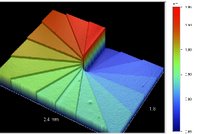 Space Daily has a report that a researcher has invented a type of filter that might let us get our first look at planets around other stars!
Space Daily has a report that a researcher has invented a type of filter that might let us get our first look at planets around other stars!So I did a little research, and lo, the report is a bit premature-- even before you take into account that we don't have funding for a space telescope to even look for planets anymore.
The hardest part about seeing other solar system planets is that stars are just so darn bright. Grover Swartzlander of the University of Arizona's College of Optical Sciences figured out a way to cancel starlight, by making this spiral staircase sliver of glass and pointing it straight at the star. Photons from the star wrap around the steps and cancel each other out, while photons from the planet are just off-axis enough to pass through and we get an image. Neat!
Except:
The steps cancel out only the exact wavelength that they happen to be sized for. Swartzlander has made a Vortex Mask that cancels out green laser light, for example. I don't know of any green laser light stars. Scaling up, he's pretty sure he can make a Vortex Mask that cancels all the wavelengths (in photonic research language that's called "achromatic"), but I don't see how that would be possible. The device works only because the steps force a specific wavelength to interfere with itself.
Making a chain of Vortex Masks, one for each color of the rainbow, now, that seems like it would approximate an achromatic mask pretty well. It's not very elegant, though.
Is the Helical Vortex Mask a photonic curiousity, or can it be developed into a device that will really let us image faint little planets by nulling a star's glare? Swartzlander has got some funding, so in a few years we'll know.

No comments:
Post a Comment